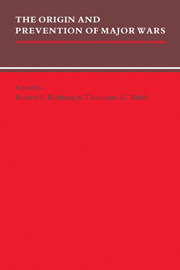Book contents
- Frontmatter
- Contents
- Introduction
- The Origins of War: Structural Theories
- The Origins of War: Explanation of Non-rational Causality
- Lessons and Analogies from Early Major Wars
- Lessons and Analogies from the World Wars
- The Origins of World War I
- Wargames: 1914–1919
- The Origins of World War II in Europe: British Deterrence Failure and German Expansionism
The Origins of World War I
Published online by Cambridge University Press: 02 December 2009
- Frontmatter
- Contents
- Introduction
- The Origins of War: Structural Theories
- The Origins of War: Explanation of Non-rational Causality
- Lessons and Analogies from Early Major Wars
- Lessons and Analogies from the World Wars
- The Origins of World War I
- Wargames: 1914–1919
- The Origins of World War II in Europe: British Deterrence Failure and German Expansionism
Summary
World War I began in eastern Europe. The war started when Serbia, Austria-Hungary, Russia, and Germany decided that war or the risk of war was an acceptable policy option. In the aftermath of the Balkan wars of 1912/13, the decision-makers in eastern Europe acted more assertively and less cautiously. The Serbian government displayed little willingness to negotiate with Vienna; in fact, some elements of the Belgrade regime worked to challenge, by violent means if necessary, Habsburg rule in Bosnia and Herzegovina. Austria-Hungary, threatened anew by the Balkan problems, grew more anxious about its declining position and became more enamored of the recent successes of its militant diplomacy. Having encouraged the creation of the Balkan League and benefited from Serbia's military triumphs, Russian policymakers displayed a new aggressiveness toward their Danubian neighbor. The German leadership, for its part, fretted more than ever about its relative position in the European system and found the new Russian self-confidence troubling. Then came the Sarajevo assassinations on 28 June 1914 of Archduke Franz Ferdinand, heir to the Austrian throne, and his wife Sophie. Within a month of these deaths, Austria-Hungary and Serbia would be at war, followed by the rest of Europe shortly thereafter.
Although the war began in eastern Europe, the events there have received only modest attention from historians. This neglect is not entirely surprising, given the Versailles “war guilt” clause against Germany and subsequent efforts to defend or denounce
- Type
- Chapter
- Information
- The Origin and Prevention of Major Wars , pp. 225 - 248Publisher: Cambridge University PressPrint publication year: 1989

